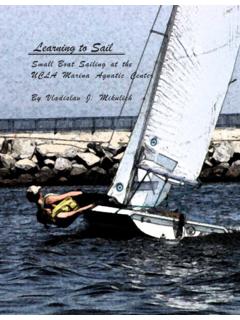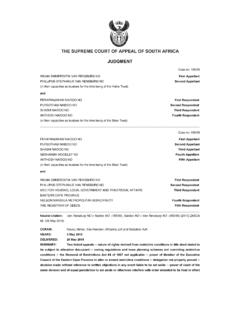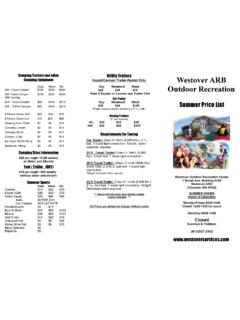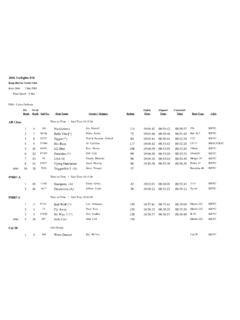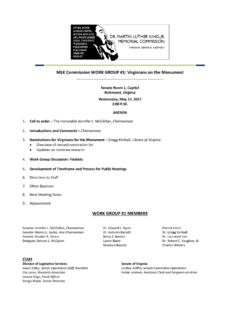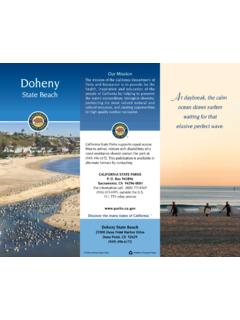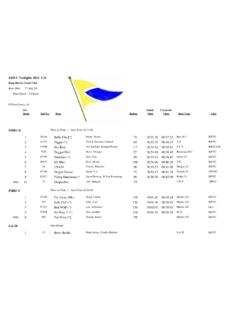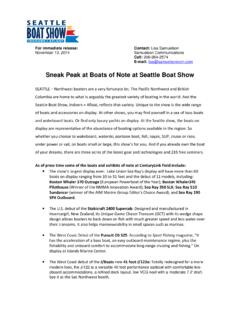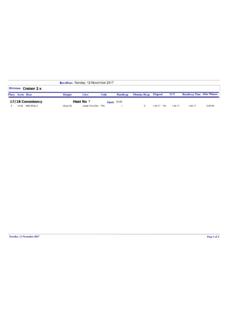Transcription of Learning to Sail - Marina Aquatic Center
1 Learning to Sail Small Boat Sailing at the UCLA Marina Aquatic Center Section 2: Introduction to Single-Handed Sailing By Vladislav J. Mikulich Learning to Sail Small Boat Sailing at the UCLA. th Marina Aquatic Center 5 revised edition Vlad Mikulich performing a headstand on the bow of a Laser (c. 2009). Original Text by Carla Thorson and Steve Orosz Original Drawings by Rob Tokar Subsequent revisions with new graphics by Steve Orosz (2001, 2004). Current revisions, additions, photographs, and graphics by Vladislav J. Mikulich Special Contributors: John Nelson, Vicky Tsoi, Kathy Luciano, Peter Boradwell, Chris Howard, Sean Silver, Crossman Willkins, and Lynn Dixon Dedication: To Aurora, you inspire me like no other.
2 Thank you! 2009 All rights reserved. No part of this book may be reproduced or transmitted in any form or by any means, electronic or mechanical, without the expressed written permission from the Editor: or . Earlier Editions 1995, 2001, 2004, 2006. COVER: Steve Orosz, UCLA Head Sailing Instructor 1995-2005 (c. 2004). Table of Contents Downwind Sailing: Zig-Zag 78. I. BASIC SAILING SKILLS. Introduction to sailing at UCLA 4 Tacking 79-80. Safety and Preparation 5-6 Gybing 81-82. Sailing Area 7 Rigging: V-15 83-86. Parts of the Boat: Capri 8-10. Derigging: V-15 87-90.
3 Wind Sensing 11. How Sailboats Work: Beginner 12 _____. Sailing Directions: Points of Sail 13-15 IV. INTRODUCTION TO CATAMARAN SAILING. Starting the Boat 16 Parts of the boat: Hobie 16 91-92. Stopping and Slowing the Boat 17 Tacking: Body Placement 93-95. Steering the Boat: Use of the Tiller 18 Gybing 96-98. Tacking 19 Trapezing/ Flying a hull 99-101. Sailing Upwind: Beating 20 Rigging: Hobie 16 102-106. Gybing 21 Derigging: Hobie 16 107-111. Navigational Rules of the Road 22-24 _____. Capsize Recovery 25-26 VI. INTERMEDIATE TO ADVANCED SAILING TOPICS. Person Overboard Recovery 27 Roll Tacking 112-113.
4 Knots Beginner: Belaying & Figure-Eight 28 Roll Gybing 114-115. Rigging: Capri 29-33 How Sails Work: Circulation Theory 116. Launching 34-35 Upwind Sailing in Gusts 117-118. Docking 36-37 Wave Sailing Upwind 119-120. Derigging: Capri 38-42 Wave Sailing Downwind 121-122. _____ Foward and Aft Torquing: Laser 123-124. II. INTRODUCTION TO SINGLE-HANDED SAILING Mast Rake 125. Parts of the Boat: Laser 43-44 Ocean Safety 126-128. Displacement Sailing vs Planing 45 Three Basic Wind Shifts 129-130. Current 131-132. Boat Trim 46-48. Local Weather: MDR 133-134. Hiking Properly 49-50.
5 Sailing by the Lee 135. Sail Controls: Laser 51-53. Introduction to Racing 136-140. Knots Intermediate: Bowline, Hitches Sheet Bend, & Coiling a line 54-55 _____. Tacking: Use of a Tiller Extension 56-57 VII. GLOSSARY 140-147. Gybing: 58-59. Dry Capsize Recovery: Walkover 60. Rigging: Laser 61-67. Derigging: Laser 68-71. _____. III. INTRODUCTION TO DOUBLE HANDED. PERFORMANCE SAILING: Parts of the Boat: V-15 72-73. Points of Sail: Speed Differentials 74. Sail Setup 75-76. Upwind Sailing: Planning 77. Vlad Mikulich, UCLA Head Sailing Instructor 2005 to present, mid-tack during reach on breezy day ( ).
6 Parts of the Boat: Laser It has been said that the Laser represents sailing in its purest form. On the water, it is just the vessel, a single sailor and whatever Mother Nature throws at her. There are no high tech gadgets or fancy equipment on a Laser. In fact, the Laser is a strict one-design class where modifications to the vessel are forbidden. In a race between two Lasers, or for that matter 100 Lasers, it is the better sailor that will prevail, not the one with the better equipped vessel as the boats are virtually identical. The boat is fairly simple to set up, yet it is capable of handling conditions ranging from the lightest breeze to gale force winds (34-47 knots).
7 There are three optional rigs (the mast, boom, and sails) that attach to an identical hull. Each sail is designed for sailors of different weight ranges. The Standard Rig was designed for sailors weighing between 160 to 190+ lbs, and has 76 square feet of sail. The Radial Rig, which has 62 square feet of sail, was designed for sailors in the weight range of 121 to 160 lbs. The Rig, which has square feet of sail ( square meters of sail), was designed for sailors within the weight range of 77 to 121 lbs. These optimal ranges are not absolute standards, but rather guidelines for being successful in a variety of racing conditions.
8 To learn more about the Laser, please visit the North American Laser Class Association at Forward Sailing II: Laser Luff Sleeve Boom Clew Hook Cunningham Grommet Cunningham Boom Vang Daggerboard Mainsheet Mast Step Mainsheet Block Outhaul and Cunningham Cleats Mainsheet Cleat Tiller Extension Grab Rail (right side of boat). Hiking Strap Tiller Traveler Traveler Blocks Starboard (left side of boat). Drain Plug Gudgeon and Pintles Port Rudder Aft (Toward the back of the boat). 43. Head (corner of the sail). LASER: The Laser is the Men's and Women's Olympic Class single-handed dinghy, and it is arguably the most Any fool can carry on, but a wise man knows how to shorten sail in popular racing vessel in the world with over 200,000 boats time.
9 Built-to-date. It is cat rigged: it has a single mast with Joseph Conrad triangular mainsail and no headsail (jib). Leech Sailing II: Laser (side of the sail). Luff (side of the sail). Batten Pocket Telltale Foot Clew (corner of the sail). (side of the sail) Cunningham Grommet Tiller Extension Tack (corner of the sail). Mainsheet Outhaul Boom Boom Vang Cunningham Cockpit Bow Eye Rudder Daggerboard Hull 44. Displacement vs Planing There are two modes of sailing for monohull vessels: displacement and planing. Most large monohulls and all slow moving small ones operate via displacement sailing.
10 Certain smaller vessels are capable of operating via planing when enough power is applied. Archimedes' Principle of Buoyancy states that an object to skim along the surface of the water using the flatter fully or partially immersed in a liquid will displace a volume portion of the aft hull. This occurs any time the boat has of water equal in weight to the weight of the object. Sailboats enough power applied to the sails to break free from the that operate via this principle are sailing in displacement wave it created. The heavier the vessel, the more power mode.
